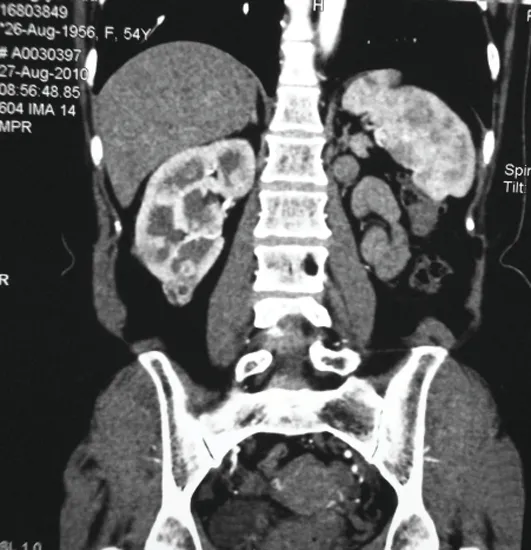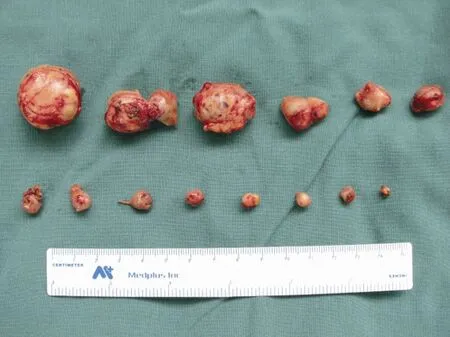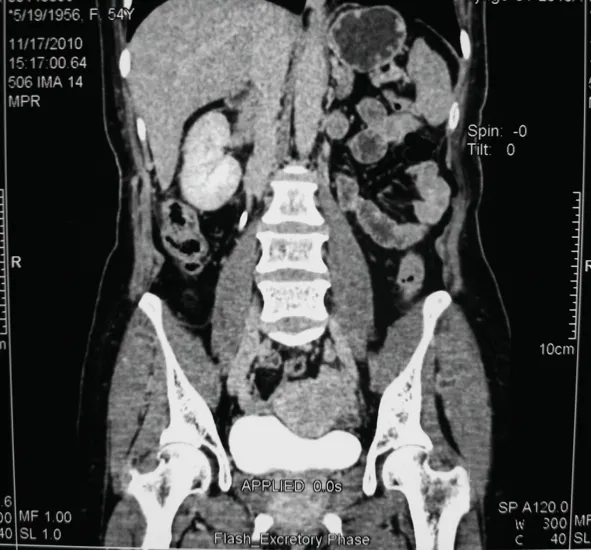Open Partial Nephrectomy in Solitary Kidney with Multiple Renal Cell Carcinoma:a Case Report
Ji-rui Niu,Quan-zong Mao,and Zhi-gang Ji*
Departments of Urology,Peking Union Medical College Hospital,Chinese Academy of Medical Sciences &Peking Union Medical College,Beijing 100730,China
RENAL cell carcinoma (RCC) in a solitary kidney presents a unique clinical challenge to urological surgeons.Partial nephrectomy (PN) or nephron-sparing surgery in this condition provides good oncological and renal fuctional outcomes with an acceptable complication rate.1,2Long-term renal function remains stable in most patients with solitary kidneys after a reduction of more than 50% in renal mass.3PN is a surgical procedure reserved for patients with a tumor in a solitary kidney,bilateral renal tumors,or renal function impairment.4The challenge of preserving renal parenchyma is significantly complicated with the discovery of multiple masses in a solitary kidney because any subsequent complications may result in a significant decline in quality of life.Particularly in the case of postoperative renal failure,dialysis becomes necessary.5
CASE DESCRIPTION
A 54-year-old woman was hospitalized because of multiple tumors in the right kidney.She had undergone left radical nephrectomy 7 years ago for clear cell RCC.Her subsequent course before hospitalization was uneventful,leaving no follow-up images.
The patient underwent a computed tomography scan in our hospital,revealing 4 separate enhancing masses in the solitary right kidney (Fig.1).Her serum creatinine was 79 μmol/L and urine creatinine was 5.2 mmol/L.Her creatinine clearance rate was calculated at 82.5 mL/min.Partial nephrectomy was performed on her,in which her renal artery blood flow was blocked by clamping prior to resection of the tumor with cooling.The ischemia time of the kidney was 59 minutes.Altogether 16 tumors were resected in the surgery (Fig.2).

Figure 1.Computed tomography displays the location of the tumor in the right kidney.
Her serum creatinine increased to 498 μmol/L after surgery and urine volume declined to 88 mL/day.The patient received dialysis the second day after surgery.Her urine volume began to increase to 200 mL/day the 11th day after surgery.The 17th day after surgery when dialysis was stopped,the patient’s serum creatinine decreased to 219 μmol/L.Her serum creatinine continued to gradually decline.A biopsy of the lesion confirmed clear cell RCC(Fig.3).Ultrasound demonstrated no evidence of RCC recurrence in the right kidney,and her serum creatinine was 189 μmol/L.Two months after operation,her serum creatinine was 122 μmol/L,and computed tomography urography demonstrated no evidence of RCC recurrence in the right kidney (Fig.4).

Figure 2.Sixteen tumors were resected from the right kidney.

Figure 3.The tumors are made up of cells with clear or granular cytoplasm.HE ×100

Figure 4.Computed tomography reveals no evidence of renal cell carcinoma recurrence in the right kidney after surgery.
DISCUSSION
The treatment goal in patients with a solitary kidney who present with RCC is to eliminate the tumor and maintain renal function, since it is very important for the patient with multiple tumors in a solitary kidney to maintain renal function. In the present case, the threshold for performing radical nephrectomy was discussed, but the patient insisted on keeping her renal function and avoiding dialysis, therefore choosing nephron-sparing surgical procedure.
Upon deciding on the nephron-sparing technique, the case became increasingly challenging because that surgical technique needs longer cold ischemia time and some tumors were close to renal pedicle. Novick5stated that pedicle clamping with surface cooling allows less than 3 hours of safe ischemia without permanent renal injury, the cold ischemia time of the present case was 59 minutes, longer than the time we usually use in partial nephrectomy. This case was notable in that no changes were observed in creatinine level despite left radical nephrectomy and right open nephrectomy for multiple tumors. Although we recognize that this patient may eventually require radical nephrectomy of her solitary kidney due to RCC, she will avoid dialysis for a long time and maintain her normal lifestyle.
In conclusion, this report described a case of partial nephrectomy in a solitary kidney with multiple RCC. That surgical procedure provides satisfactory result in renal function preservation and long-term progression-free survival.
1.Lau WK,Blute ML,Weaver AL,et al.Matched comparison of radical nephrectomyvs.nephron-sparing surgery in patients with unilateral renal cell carcinoma and a normal contralateral kidney.Mayo Clin Proc 2000;75:1236.
2.Lerner SE,Hawkins CA,Blute ML,et al.Disease outcome in patients with low stage renal cell carcinoma treated with nephron sparing or radical surgery.J Urol 1996;155:1868-73.
3.Nosnik IP,Mouraviev V,Nelson R,et al.Multiple nephron-sparing procedures in solitary kidney with recurrent,metachronous,nonfamilial renal cell carcinoma.Urology 2006;68:1343.e1-3.
4.Touijer K,Jacqmin D,Kavoussi LR,et al.The expanding role of partial nephrectomy:a critical analysis of indications,results,and complications.Eur Urol 2010;57:214-22.4.Touijer K,Jacqmin D,Kavoussi LR,et al.The expanding role of partial nephrectomy:a critical analysis of indications,results,and complications.Eur Urol 2010;57:214-22.
5.Novick AC.Renal hypothermia:in vivoandex vivo.Urol Clin North Am 1983;10:637-44.
 Chinese Medical Sciences Journal2011年4期
Chinese Medical Sciences Journal2011年4期
- Chinese Medical Sciences Journal的其它文章
- Efficacy of Surgical Therapy for Carotid Body Tumors
- Neurological Manifestations of Takayasu Arteritis
- Efficacy and Safety of Low Molecular Weight Heparin Prophylaxis for Venous Thromboembolism Following Lumbar Decompression Surgery
- Contrary Regulation of TIMP-1 and MMP-9 by Hepatocyte Growth Factor Antibody after Lung Injury
- Atypical Chronic Myeloid Leukaemia with Trisomy 13:a Case Report
- Surgical Removal of a Giant Vegetation on Permanent Endocavitary Pacemaker Wire and Lead
